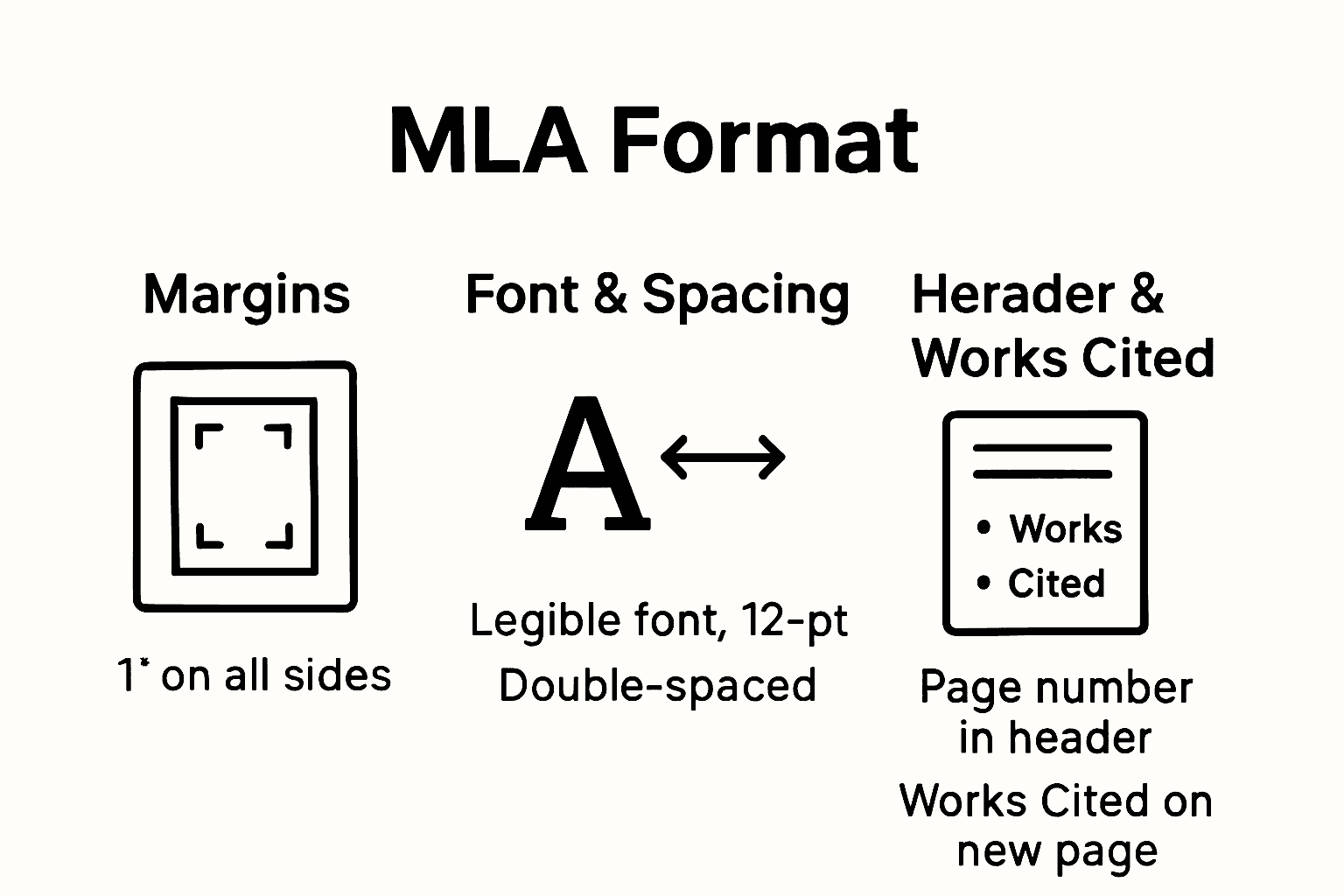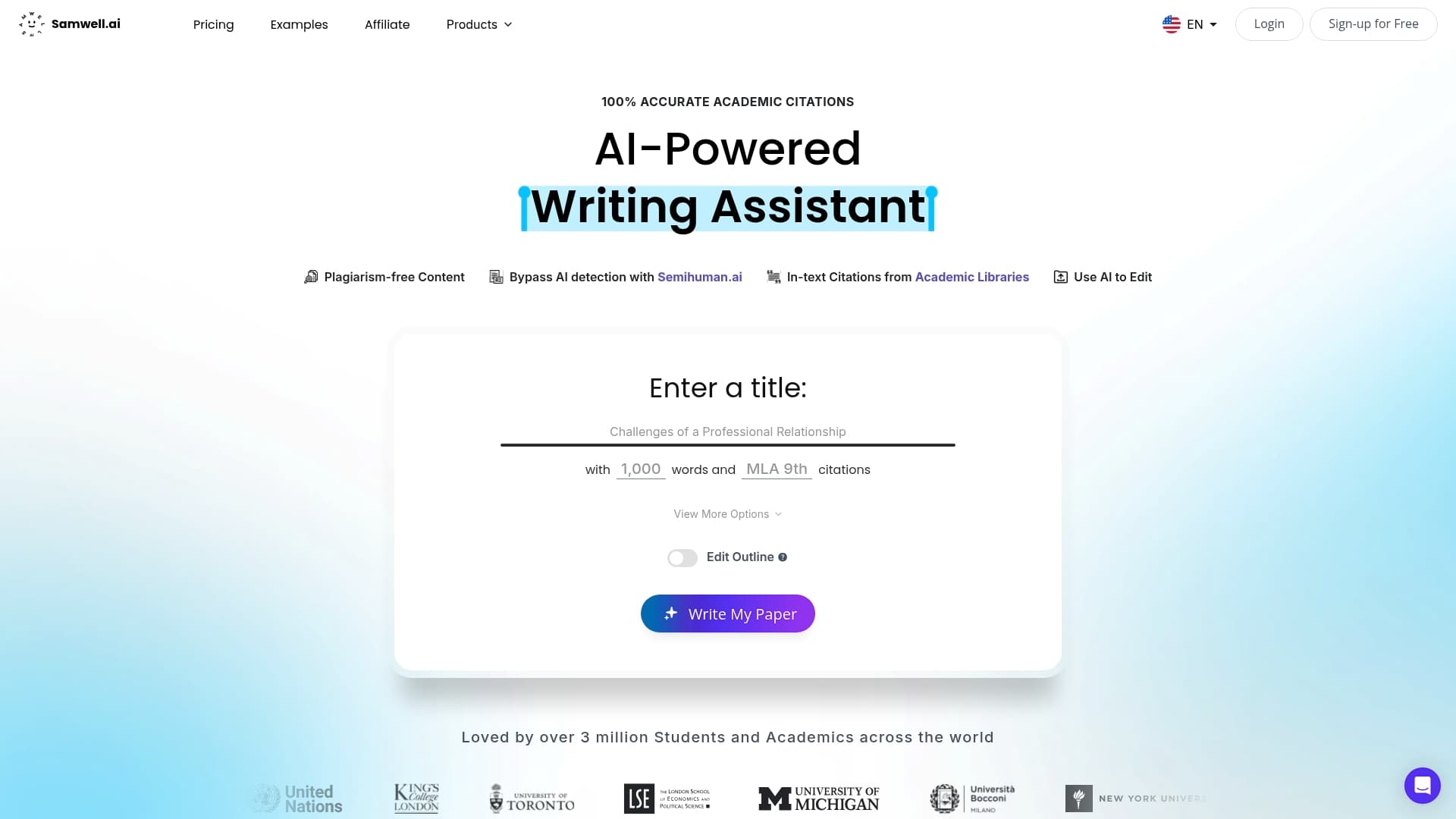Blog
Learning Materials
Outline for Essay MLA Format: Step-by-Step Guide 2025
Updated: July 2, 2025

Writing a college essay can feel like navigating a maze of confusing rules and formats. Here is something few students realize. MLA format is accepted by over 1,100 scholarly and literary journals worldwide, making it the backbone of academic communication in the humanities. Most people think MLA is about nitpicky formatting or font choices, but the real power is in how it helps you organize ideas, avoid plagiarism, and present your arguments clearly enough to impress even the toughest professors.
Table of Contents
- Understanding MLA Format And Its Importance Dockerfile README.md email-templates i18n-config.ts i18nConfig.ts next-sitemap-samwell.config.js next-sitemap-semihuman.config.js next.config.js node_modules package-lock.json package.json process_content.js public scripts src svgr.d.ts translations tsconfig.json What Makes MLA Format Essential Dockerfile README.md email-templates i18n-config.ts i18nConfig.ts next-sitemap-samwell.config.js next-sitemap-semihuman.config.js next.config.js node_modules package-lock.json package.json process_content.js public scripts src svgr.d.ts translations tsconfig.json Core Components Of MLA Formatting Dockerfile README.md email-templates i18n-config.ts i18nConfig.ts next-sitemap-samwell.config.js next-sitemap-semihuman.config.js next.config.js node_modules package-lock.json package.json process_content.js public scripts src svgr.d.ts translations tsconfig.json Preventing Plagiarism Through Proper Citation
- Key Elements Of An MLA Essay Outline Dockerfile README.md email-templates i18n-config.ts i18nConfig.ts next-sitemap-samwell.config.js next-sitemap-semihuman.config.js next.config.js node_modules package-lock.json package.json process_content.js public scripts src svgr.d.ts translations tsconfig.json Structural Components Of An Effective MLA Outline Dockerfile README.md email-templates i18n-config.ts i18nConfig.ts next-sitemap-samwell.config.js next-sitemap-semihuman.config.js next.config.js node_modules package-lock.json package.json process_content.js public scripts src svgr.d.ts translations tsconfig.json Principles Of Outline Construction Dockerfile README.md email-templates i18n-config.ts i18nConfig.ts next-sitemap-samwell.config.js next-sitemap-semihuman.config.js next.config.js node_modules package-lock.json package.json process_content.js public scripts src svgr.d.ts translations tsconfig.json Thesis Development And Supporting Arguments
- Step-By-Step Example Of MLA Outline Dockerfile README.md email-templates i18n-config.ts i18nConfig.ts next-sitemap-samwell.config.js next-sitemap-semihuman.config.js next.config.js node_modules package-lock.json package.json process_content.js public scripts src svgr.d.ts translations tsconfig.json Selecting A Topic And Developing A Thesis Dockerfile README.md email-templates i18n-config.ts i18nConfig.ts next-sitemap-samwell.config.js next-sitemap-semihuman.config.js next.config.js node_modules package-lock.json package.json process_content.js public scripts src svgr.d.ts translations tsconfig.json Constructing The Detailed Outline Dockerfile README.md email-templates i18n-config.ts i18nConfig.ts next-sitemap-samwell.config.js next-sitemap-semihuman.config.js next.config.js node_modules package-lock.json package.json process_content.js public scripts src svgr.d.ts translations tsconfig.json Formatting And Structural Considerations
- Common Mistakes And Best Practices Dockerfile README.md email-templates i18n-config.ts i18nConfig.ts next-sitemap-samwell.config.js next-sitemap-semihuman.config.js next.config.js node_modules package-lock.json package.json process_content.js public scripts src svgr.d.ts translations tsconfig.json Formatting And Structural Errors Dockerfile README.md email-templates i18n-config.ts i18nConfig.ts next-sitemap-samwell.config.js next-sitemap-semihuman.config.js next.config.js node_modules package-lock.json package.json process_content.js public scripts src svgr.d.ts translations tsconfig.json Citation And Source Documentation Challenges Dockerfile README.md email-templates i18n-config.ts i18nConfig.ts next-sitemap-samwell.config.js next-sitemap-semihuman.config.js next.config.js node_modules package-lock.json package.json process_content.js public scripts src svgr.d.ts translations tsconfig.json Academic Integrity And Documentation Best Practices
Quick Summary
| Takeaway | Explanation |
|---|---|
| Understand MLA Format's Importance | MLA format provides a standard structure for academic writing, promoting consistency and credibility across essays and research papers, particularly in the humanities. |
| Master Structural Elements of an Outline | A comprehensive MLA essay outline includes a clear thesis, main headings for arguments, and specific subheadings for supporting evidence, all organized in a hierarchical structure. |
| Pay Attention to Citation Practices | Proper citation in MLA format is crucial for preventing plagiarism, maintaining research integrity, and allowing readers to verify sources accurately. |
| Avoid Common Formatting Errors | Ensure adherence to MLA formatting rules by checking for correct font, spacing, header placement, and accurate citation practices to uphold academic professionalism. |
| Foster Academic Integrity | Accurate source attribution, consistent formatting, and credible references are essential best practices for maintaining high standards in academic writing. |
Understanding MLA Format and Its Importance
Modern Language Association (MLA) format represents a standardized academic writing framework that provides clear guidelines for research papers, essays, and scholarly documents. This systematic approach ensures consistent presentation and proper source attribution across academic disciplines, particularly in humanities and liberal arts.
What Makes MLA Format Essential
MLA format goes beyond mere aesthetic preferences. It establishes a universal language for academic communication, enabling researchers and students to present their work with precision and credibility. Learn more about academic writing standards that help maintain scholarly integrity.
According to University of North Dakota's Writing Center, MLA style is adopted by over 1,100 scholarly and literary journals worldwide. This widespread acceptance underscores its significance in academic writing. The format provides a structured approach that helps writers organize information systematically while giving proper credit to original sources.
Core Components of MLA Formatting
MLA format encompasses several critical elements that transform a standard document into a professionally structured academic paper. These components include:
- Page Layout: Standardized margins (1 inch on all sides), readable font (typically Times New Roman, 12-point), and double spacing
- Header and Pagination: Last name and page number in the top right corner
- In-text Citations: Parenthetical references that directly credit source authors
- Works Cited Page: Comprehensive list of all sources referenced in the document

The Lumen Learning Academic Writing Course emphasizes that proper MLA formatting enhances document clarity and ensures consistent organization. By following these guidelines, writers create papers that are not just informative but also professionally presented.
Preventing Plagiarism Through Proper Citation
One of the most critical functions of MLA format is preventing academic misconduct. Widener University Libraries highlight that accurate source attribution is fundamental to maintaining research integrity. MLA's detailed citation guidelines ensure that researchers:
- Provide clear credit to original authors
- Allow readers to verify research sources
- Demonstrate academic honesty
- Avoid unintentional plagiarism
By implementing these systematic citation methods, students and researchers create transparent, credible academic documents that meet the highest scholarly standards. Understanding and applying MLA format is not just about following rules but about participating in a global academic dialogue with respect and precision.
Key Elements of an MLA Essay Outline
Creating a comprehensive MLA essay outline requires strategic planning and a structured approach that transforms complex ideas into a clear, logical framework. This critical preparatory step serves as a roadmap for your academic writing, ensuring coherence and systematic presentation of your arguments. Check out our advanced outlining techniques to elevate your academic writing skills.
Structural Components of an Effective MLA Outline
According to the Purdue Online Writing Lab, a robust MLA essay outline comprises several key structural elements that guide your writing process. These elements include a clear thesis statement, main headings representing primary arguments, and detailed subheadings that provide specific supporting evidence.
The standard alphanumeric outline format follows a hierarchical structure:
- Roman Numerals (I, II, III): Represent main sections or primary arguments
- Capital Letters (A, B, C): Indicate major supporting points within each main section
- Arabic Numerals (1, 2, 3): Provide specific details or examples
- Lowercase Letters (a, b, c): Offer additional explanatory information
To provide a quick overview of the structural elements used in an MLA outline, the following table summarizes each level, its symbol, and its purpose:
A clear overview of MLA outline structure levels and their functions:
| Outline Level | Symbol Used | Purpose |
|---|---|---|
| Main Section | Roman Numerals (I, II) | Primary arguments/sections |
| Major Supporting Point | Capital Letters (A, B) | Main support points within a section |
| Specific Details | Arabic Numerals (1, 2) | Examples or further details |
| Additional Explanation | Lowercase Letters (a, b) | Extra clarification or explanation |
Principles of Outline Construction
Academic writing experts emphasize the importance of maintaining parallel structure throughout your outline. This means each heading and subheading should follow a consistent grammatical form. For instance, if you start a heading with a verb, all subsequent headings should begin with a verb.
Consider these critical principles when constructing your outline:
- Ensure logical progression of ideas
- Maintain consistent grammatical structure
- Balance the depth of information across sections
- Align subpoints directly with their corresponding main arguments
Thesis Development and Supporting Arguments
A compelling MLA essay outline centers around a strong thesis statement that clearly articulates your primary argument. Each subsequent section should directly support and expand upon this central claim. Widener University's Writing Guidelines recommend developing your outline by first identifying your core thesis, then systematically breaking down the supporting evidence into coherent sections.
When developing your outline, consider these strategic approaches:
- Identify your primary argument
- Select 3-4 strong supporting points
- Gather credible evidence for each point
- Arrange arguments in a logical sequence
- Anticipate potential counterarguments
By meticulously crafting your MLA essay outline, you create a powerful framework that not only guides your writing process but also ensures a structured, persuasive academic document. The outline serves as more than a mere organizational tool it becomes a blueprint for intellectual exploration and articulate scholarly communication.
Step-by-Step Example of MLA Outline
Creating an effective MLA outline requires careful planning and a systematic approach. Explore our comprehensive writing guide to master the art of academic writing. The process involves transforming your research and ideas into a clear, structured document that guides your writing from start to finish.
Selecting a Topic and Developing a Thesis
The foundation of any successful MLA outline begins with a well-defined topic and a strong thesis statement. According to the Purdue Online Writing Lab, an effective outline starts by clearly articulating your central argument. Consider this example of a research paper on climate change:
Thesis: Global climate change demands immediate multifaceted interventions across environmental, economic, and social systems to mitigate its devastating long-term impacts.
Outline Structure:
- I. Introduction
- A. Background on global climate change
- B. Significance of the issue
- C. Thesis statement
Constructing the Detailed Outline

Academic writing experts recommend using the alphanumeric outline format. Here's a comprehensive example demonstrating the full outline structure:
Detailed MLA Outline Example: Climate Change Interventions
-
I. Introduction
-
A. Global climate change overview
-
B. Current environmental challenges
-
C. Thesis statement
-
II. Environmental Impact
-
A. Rising global temperatures
-
- Polar ice cap melting
-
- Sea level rise
-
B. Ecosystem disruption
-
- Biodiversity loss
-
- Habitat destruction
-
III. Economic Consequences
-
A. Agricultural challenges
-
- Crop yield reduction
-
- Food security risks
-
B. Economic disruption
-
- Infrastructure damage
-
- Resource scarcity
-
IV. Social and Humanitarian Implications
-
A. Population displacement
-
- Climate refugees
-
- Migration patterns
-
B. Health risks
-
- Increased disease transmission
-
- Nutritional challenges
-
V. Proposed Interventions
-
A. Environmental strategies
-
- Renewable energy adoption
-
- Carbon emission reduction
-
B. Economic solutions
-
- Green technology investment
-
- Sustainable development policies
-
VI. Conclusion
-
A. Recap of key findings
-
B. Importance of comprehensive action
-
C. Call to global collaboration
Formatting and Structural Considerations
The University of Arizona Global Campus Writing Center emphasizes that while MLA does not mandate a specific outline format, consistency and clarity are paramount. Key considerations include:
- Maintain parallel grammatical structure
- Ensure logical progression of ideas
- Use consistent indentation
- Balance detail across main sections
- Align subpoints with primary arguments
An effective MLA outline serves as a roadmap, transforming complex research into a structured, coherent academic document. By following these guidelines, you create a powerful framework that guides your writing process and ensures a well-organized, persuasive essay.
Common Mistakes and Best Practices
Mastering MLA format requires attention to detail and understanding of common pitfalls that can undermine the quality of academic writing. Discover advanced formatting strategies to elevate your academic documents and avoid potential errors.
Formatting and Structural Errors
According to Nivia Tech's Academic Writing Guide, several critical formatting mistakes can compromise the professionalism of your document. The most prevalent errors include:
-
Incorrect Font and Spacing
-
Use 12-point Times New Roman font
-
Ensure double-spacing throughout the document
-
Maintain 1-inch margins on all sides
-
Page Numbering Issues
-
Include page numbers in the upper right corner
-
Precede page numbers with your last name
-
Number every page, including the Works Cited page
To help ensure proper formatting, the following table summarizes common MLA formatting errors and recommended corrections:
This table highlights frequent MLA formatting mistakes and how to correct them:
| Formatting Error | Common Mistake | Recommended Practice |
|---|---|---|
| Font and Spacing | Using improper font or line spacing | 12-point Times New Roman, double-spaced |
| Margin Settings | Margins set incorrectly | 1-inch margins on all sides |
| Header/Page Numbering | Missing or misplaced header/page number | Last name + page number, top right |
| Inconsistent Formatting | Irregular format across sections | Maintain consistency throughout document |
Citation and Source Documentation Challenges
The Purdue Online Writing Lab highlights several critical mistakes in source citation and documentation:
-
In-text Citation Errors
-
Incorrect parenthetical references
-
Failing to cite direct quotes
-
Inconsistent citation formatting
-
Works Cited Page Problems
-
Incorrect alphabetization of sources
-
Improper hanging indent formatting
-
Missing essential publication information
Academic Integrity and Documentation Best Practices
Academic Writing Experts recommend the following strategies to maintain high standards of academic writing:
-
Plagiarism Prevention
-
Always attribute sources accurately
-
Use direct quotes sparingly
-
Paraphrase with proper citations
-
Source Evaluation
-
Use credible, peer-reviewed sources
-
Verify the reliability of academic references
-
Maintain a balanced perspective in research
Common formatting mistakes can significantly impact the credibility of your academic work. The University of Arizona Global Campus Writing Center emphasizes that attention to detail is crucial. Some additional best practices include:
- Consistent formatting across all document sections
- Careful proofreading of citations and references
- Using reliable citation management tools
- Consulting your institution's specific guidelines
By understanding and avoiding these common mistakes, you can create a professional, credible MLA-formatted document that meets the highest academic standards. Remember that precision in formatting is just as important as the content itself. Take the time to review and refine your document, ensuring every aspect aligns with MLA guidelines.
Frequently Asked Questions
What is MLA format and why is it important?
MLA format is a standardized writing style used primarily in the humanities. It provides guidelines for consistent presentation and proper source attribution, which enhances the credibility of academic work.
How do I structure an MLA essay outline?
An MLA essay outline typically includes a clear thesis statement followed by main headings for primary arguments and subheadings for supporting evidence, all organized in a hierarchical structure using Roman numerals, capital letters, Arabic numerals, and lowercase letters.
What are common mistakes to avoid in MLA formatting?
Common mistakes include using incorrect font or spacing, failing to include proper page numbering, and not following consistent citation practices. It’s important to adhere to the guidelines for font, spacing, margins, and citations to maintain professionalism in your document.
How can I prevent plagiarism when using MLA format?
To prevent plagiarism, always provide accurate citations for your sources, use direct quotes sparingly, and ensure that all borrowed ideas are properly attributed. Following MLA's citation guidelines helps maintain academic integrity.
Struggling With MLA Essay Outlines? Unlock Effortless Academic Writing with Samwell.ai
Are you feeling overwhelmed by the pressure of organizing your research and structuring an effective MLA essay? You are not alone. Many students find themselves stressed about creating perfect outlines, avoiding formatting mistakes, and ensuring their work meets strict academic standards. The article above highlighted how detail-oriented MLA structure, source attribution, and formatting rules can turn even a simple assignment into a daunting task.

Take the uncertainty out of your next essay. With Samwell.ai, you have access to an AI platform built specifically for students and academics who want to create credible, original papers quickly. Use guided outlines to organize ideas step by step, tap into custom editing tools that adjust to MLA requirements, and check your work with real-time AI detection. Stop worrying about formatting errors or plagiarism risks. Start your journey with Samwell.ai and experience a better, faster way to master MLA essays. Make your next assignment your best yet by visiting Samwell.ai and taking the first step now.
Recommended
Generate essays with Samwell.ai
Whether you’re a publisher, professor, journalist, or student, let us tailor a plan just for you.Most Read Articles

Your Guide to Help Writing a Essay Successfully
Expert tips for help writing a essay - from crafting a thesis to structuring your essay effectively.

How to Write Critical Thinking Essay: Expert Tips
Expert tips for writing a critical thinking essay. Learn how to structure, choose topics, and use evidence effectively.'

How to Write a Good Hook: A Step-by-Step Guide
Master the art of crafting a good hook with our guide. Create compelling openers for a memorable first impression.

